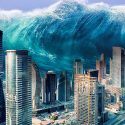For billions of years, the Sun’s gravitational has kept Earth’s orbit on a steady and reliable path. But this rogue star has other plans for our planet. This sudden shift in Earth’s gravity would make our planet break away from orbiting the Sun. And now, for the first time in our planet’s history, we would be drifting through space without any direction.
How fast would Earth travel? Could we survive the extreme temperatures of space? And could the Earth fly through the asteroid belt?
Right now, Earth is moving away from the Sun at the rate of 1.5 cm (.6 in) per year. But if a rogue star, a star that’s not gravitationally bound to any galaxy, came close enough to our planet, our distance from the Sun could increase. The gravity exerted by the star might even be strong enough to nudge the Earth onto a one-way trip throughout the Universe.
Our planet would become a living spaceship, hurtling through the darkness of space, with all humanity as its passengers. But if we kept moving further away from the Sun, how long would our atmosphere last?
Gravity and motion are the unseen forces that hold together our existence in this world. If the Earth were stationary, the Sun’s gravity would suck our planet right into its flames. Fortunately, Earth’s orbit keeps us safe from that threat. But if our world were knocked off course, we would travel the galaxy at the same speed we orbit the Sun. Earth would take us on a nonstop flight at 30 km/s (67,108 mph). That’s 125 times faster than a jet plane.
But what would happen to the Moon? Because the Moon remains tethered to the Earth’s gravity, we might have an extra passenger on this road trip. But that may not be the case for long. We’ll talk about that later.
As Earth leaves its orbit, our neighbor planet, Venus, would fade from sight. But we’d be losing more than a view. Soon, our world would leave the habitable zone in our Solar System. This area is the distance from the Sun in which water can exist as a liquid, providing Earth with the building blocks of life. But if something knocked Earth out of the habitable zone, our planet’s water supply would begin to freeze over. We’d have to thaw ice just for a drink of water. And while our thin atmosphere might remain, it wouldn’t provide us with a buffer between our planet and the dark cold of space.
After three months on its new heading, Earth would fly by our sister planet, Mars. , we would only receive 44% of the sunlight as we once had. Unable to go through photosynthesis, the conversion of light to energy, the plant life on Earth’s surface would die out. If you want to jump ship and colonize Mars, this would be your last chance. You’ll never see Mars again.
One month after leaving Mars behind us, we would arrive at our first major obstacle, the asteroid belt. Located between Jupiter and Mars, this collection of small, rocky, metallic bodies are leftovers from the creation of the Solar System 4.6 billion years ago. The almost 2 million asteroids floating in this belt range in size from a pebble to 1 km (.5 mi). And if an asteroid pounded our planet, that could be it for life as we know it. In 2013, a space rock from this belt, measuring 17 m (56 ft) in diameter, exploded above Russia. It injured over 1,000 people and damaged thousands of buildings. The energy the explosion released was almost 40 times more destructive than the nuclear bomb dropped on Hiroshima.
Fortunately, the distance between asteroids is about 1 million km (600,000 mi). So if we pass by one asteroid, we may not see another for a while. This tense journey from one end of the asteroid belt to the other would last two months. And if Earth made it through the belt intact, we would be greeted by the first gas giant in our galaxy, Jupiter.
As we pass by, the gravity exerted by this gas giant might be strong enough to steal our Moon. The one moon that’s protected our home for billions of years might become Jupiter’s 80th companion. We would see the Great Red Spot, a storm twice the size of Earth that’s been raging for hundreds of years. But don’t stay outside too long admiring this view. Our planet could reach the same temperature as the top of Jupiter’s clouds, a staggering -145 °C (-229 °F). That’s because we would only receive 3.6% of the sunlight we had in our natural orbit.
While most life on Earth might be extinct at this point, underneath the sheet of ice that was once our oceans, something might be stirring. After all, Europa, one of Jupiter’s moons, is believed to have twice as much water as Earth does, and it’s all below the icy surface. On Earth, scientists have found microbial life in the arctic surviving in temperatures as low as -25 °C (-13 °F).
Microbes living near hydrothermal vents on the ocean floor might be the last living life forms on our planet. Thriving from the chemical energy released from the Earth’s core, these microscopic organisms might be able to survive Earth’s new and extreme temperatures.
As long as Earth survives intact, these microscopic lifeforms would float endlessly through space with our rogue planet. And Earth, a planet with over 4 billion years of history, would start a new chapter by surfing through the Universe. But one thing is clear. If our planet were to stop orbiting the Sun, the view might be spectacular, but you wouldn’t be around long to enjoy it.
Sources
- “What If Earth Stopped Orbiting The Sun?”. 2021. phys.org.
- “How Far Away Is Jupiter?”. Nola Taylor Redd. 2021. space.com.
- “How Long Does It Take To Get To Mars?”. Nola Taylor Redd. 2021. space.com.
- “Earth Is Spiraling Away From The Sun For Now, But Will Eventually Crash Into It”. Siegel, Ethan. 2021. Forbes.
- “See Earth And Venus From Mars In Amazing Photos From NASA’s Curiosity Rover”. Howell, Elizabeth. 2021. space.com.
- “Why Is Mars Red?”. Natalie Wolchover. 2021. space.com.

























